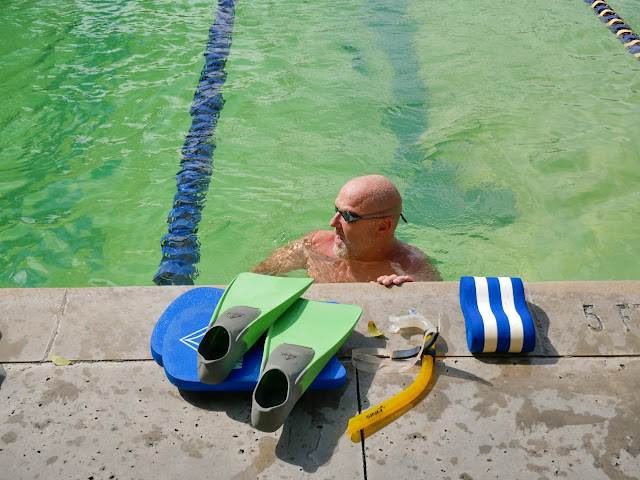This is a shot of the Deep Eddy Pool from up at the bathhouse. The deep side of the pool, separated by a concrete wall from the shallow end, is 33.3 meters across. The water is usually near 68 degrees because it comes from underground wells. In the top right hand corner you can see Lady Bird Lake, which runs through the middle of downtown Austin. The pool is owned by the City of Austin.
These are the cascading steps that lead down to the pool.
The shallow end of the pool is in the foreground and the deeper end, with lap lanes, is in the background. The pool opens at 8 a.m. and closes at 8 p.m., all week long. It's not heated but the water is changed out from a series of deep wells every other day so it doesn't have time to cool down (too much). I find 68 degrees (water temp) to be just on this side of bearable. One swims faster in cold water because you can really feel the water resistance on your hands, arms and feet. Also, it seems one recovers quicker between sets in colder water. I'm not anxious to check my lower limits of temp tolerance any time soon.
Some lanes are designated "Circle" lanes and if you are in one you must welcome in anyone who wants to swim with you. Up on the right and back on the right. A circle. Your right side always next to the lane line. In other lanes the protocol is to ask a lap swimmer who is already in the lane if they are willing to split -- sharing the lane. If it gets crowded a non-Circle lane can be converted to a lap lane to accommodate more swimmers but one must have the consensus of each person already swimming in the lane. Seems to work fine in the Fall and Winter when attendance is lower.
Emmett's swim toys.
My usual swim partner, Emmett, getting in some extra laps with Julie.
We like to get in between 2500 and 3500 yards in a typical midday workout.
Emmett pausing between sets.
A view from the deep end.
Looking back up at the bathhouse. The bathhouse has separate areas for men and women (duh) and they are constructed as courtyards with no roof. It's fun to take showers while being able to look up at the sky and the clouds. Less fun, I imagine, if it is sleeting or snowing....or the wind is particularly snippy.
A nicely synchronized turn with kkckboards.
After a long, hard swim you still have to negotiate the stairs.
A fun view.
I don't know what your schedule is but when I am not booked for a specific job I can schedule office work or post production any way I want. I got up late this morning and met my video "mentor" James for coffee. He's just back from Bozeman, Montana, where he was shooting interviews. His stories are always pretty amazing. Today's was no exception.
After our coffee meeting I headed to the pool to swim at 11:00 am with Emmett. The air temp was in the mid-70's and we had great sun today. The water was its usual chilly 68 degrees but four or five laps of sprinting finally gets me warmed up. We knocked out a good hour of swimming and I headed out to the car to grab a camera. I knew that VSL readers were anxious to see where I'm swimming now.
I had a Panasonic G85 in the car, along with the 12-60mm lens, so I grabbed that and headed back down to the pool. That camera and lens is a wonderful combo to keep in the car. Small and light and, contrary to web chatter, perfect color right out in the Jpegs.
Deep Eddy Pool cost $3 for adults who are city residents, $8 for people from out of town and $1 for people 62 and over. I have an old punch card I never used up and it now has five swims left on it. I should use it up just in time for my birthday, at which time I'll click over to 62. Four days after that we hit November 1st and pool admission will be free until sometime in March. There are lifeguards on the deck. So far it's a decent and adventurous choice of location at which to keep up my swimming skills.
Since there's less competition most days (compared to our old stomping grounds) I'm also adding in a few more longer runs each week. And, yes, you can catch the Hike and Bike trail (best running course in Austin) just outside the Deep Eddy Pool. See you there.


































